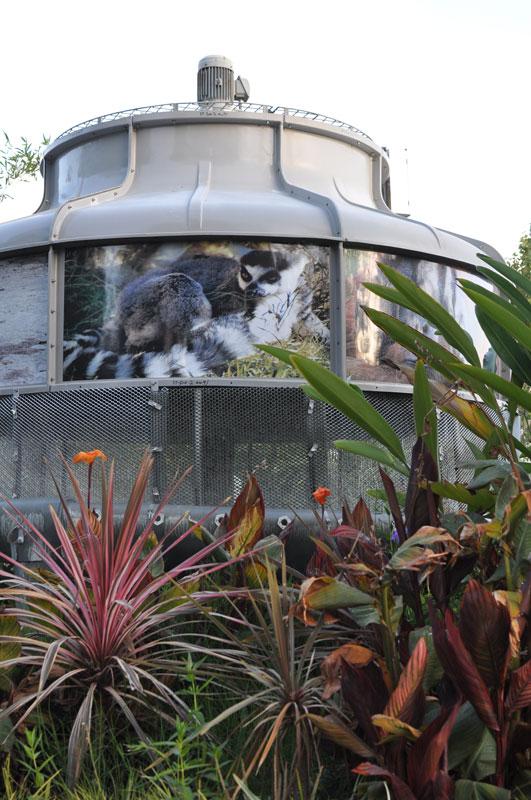
Every day on their way to classes or to their cars, students walk by CSUN’s tropical rainforest. Walking by, students see lots of plants, colorful flowers and eight different towers with pictures of rainforest animals on them.
CSUN’s tropical rainforest is equipped with a fuel satellite plant and eight chilling towers. The fuel cell is a plant that generates electrical power without pollution because it only uses hydrogen and oxygen to operate.
Bill Sullivan, the energy manager for Physical Plant Management (PPM), said the purpose of the fuel cell is to use the excess and waste water from the fuel cells to make it come out one gallon per minute per unit. There are four units, 24 hours a day, seven days a week.
“We didn’t want to just dump that water down the drain so in order to use that water we came up with a subtropical rainforest because it’s so much water. Also, the purpose is to absorb as much of the CO2 as we possibly can,” Sullivan said.
When looking at it, the circular devices are cooling towers for chillers that are in the satellite plant. Those make cold water for air conditioning on campus but the heat is rejected from the condensers, cooling towers create the warm micro climate for rainforest as well, Sullivan explained.
“Basically, it’s just equipped with as much CO2 as we can coming out the fuel cell and to make use of the waste water from the fuel cell,” he said.
Sullivan said the fuel cells electrically are 45 percent efficient versus the power coming out of your plug, which is about 33 percent efficient.
CSUN has only had its subtropical rainforest just less than a year and is already established as one of the leaders of sustainable systems for all academic institutions worldwide.
According to Tom Brown, executive director and facility manager of the PPM, the fuel cells have been part of the CSUN community for several years. The rainforest will be celebrating its one-year anniversary next month.
Brown said CSUN has saved a substantial amount of money by investing in the fuel cells and the subtropical rainforest.
“We’ve already saved on the new science building,” Brown said. “On that building alone, engineers estimated that by us doing this fuel cell chiller plant we saved that building $1.1 million. On the performing arts center we saved another $1.3 million. We’ve already saved $2.4 million on just those two projects. We chose to build this fuel cell in and the 2000-ton chiller plant to take care of the future capital constructions needs and by doing that we saved money on the next future building for the next 25 years. It was a big investment but in return we are so substantial – better classrooms.”
Brown said by building our own very efficient infrastructure, it is nearly 80 percent efficient and has reduced the environmental impacts of the campus’ electrical system by 13.4 percent.
Junior biology major Jeanine Chavez said she is pleased with CSUN’s actions to be more green.
“I’ve been to a few different colleges, junior colleges and universities and I’ve never seen anything like this rainforest,” said Chavez, 23. “It’s not only a pretty sight but so much more. Other campuses should take this as an example and follow in our footsteps because it would make the world a better and much healthier place.”
Sullivan said the whole project is designed to be very visible to the students and people living on campus.
“We have it visible so people are more aware of what is going on,” he said.
Future plans for the rainforest include giving students the opportunity to take and weigh the bamboo the rainforest produces to determine the CO2, build things such as garden gazebos, furniture, or artwork and sell it to the community. In that process students can identify how much long-term carbon avoidance they have created and contribute to being green.





